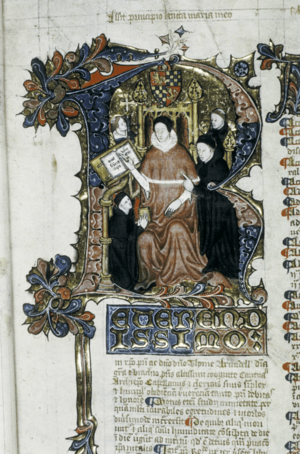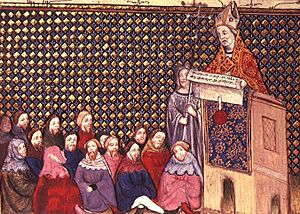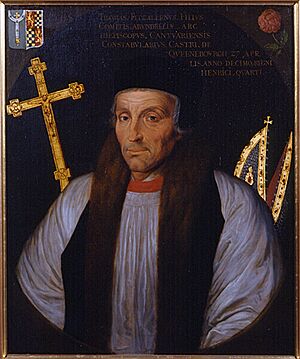Thomas Arundel facts for kids
Quick facts for kids Thomas Arundel |
|
|---|---|
| Archbishop of Canterbury | |

Late-14th-century illumination depicting Arundel
|
|
| Church | Roman Catholic |
| Appointed | 25 September 1396 |
| Reign ended | 19 February 1414 |
| Predecessor | William Courtenay |
| Successor | Henry Chichele |
| Other posts | |
| Orders | |
| Consecration | 9 April 1374 by William Whittlesey |
| Personal details | |
| Born | 1353 Etchingham, Sussex, Kingdom of England |
| Died | 19 February 1414 (aged 60–61) |
Thomas Arundel (born 1353 – died 19 February 1414) was an important English church leader. He held powerful jobs like Lord Chancellor and Archbishop of York when King Richard II was in charge. He also became Archbishop of Canterbury twice, from 1397 and then again from 1399 until he died. Arundel was a strong opponent of a group called the Lollards. He played a big part in helping Richard II's cousin, Henry Bolingbroke, become King Henry IV.
Contents
Thomas Arundel's Story
Early Life and Church Career
Thomas Arundel was born around 1353, likely in Etchingham, England. He was a younger son of a powerful family, the Fitzalans. His father was Richard Fitzalan, 3rd Earl of Arundel. Thomas had two older brothers. One, Richard Fitzalan, 4th Earl of Arundel, was later executed for opposing King Richard II.
Thomas studied at Oriel College, Oxford. However, he didn't enjoy his time there much. In 1373, he was made Bishop of Ely. This important church position was given to him because of his family's high status. Ely was a very wealthy role, and it seemed to interest the young bishop.
Rising in Power and Politics
Arundel's brother, Richard, became a strong opponent of King Richard II. This pulled Thomas into the world of politics. From 1386 to 1388, England faced a serious crisis. Thomas Arundel found himself involved in efforts by powerful lords to control the king's decisions.
In 1388, Arundel was promoted to Archbishop of York. This was a very high position. It showed how much influence the group he was with had gained.
Arundel served as Lord Chancellor twice during King Richard II's reign. He held this role from 1386 to 1389 and again from 1391 to 1396. Despite his political work, he was known for encouraging religious devotion in the northern part of England. He was also good at finding talented people to help him.
Becoming Archbishop of Canterbury
On 25 September 1396, Arundel became Archbishop of Canterbury. This was the most important church position in England. But just a year later, King Richard II exiled him. The king was fighting back against his enemies. Arundel was replaced by Roger Walden.
Arundel spent his exile in Florence. The Pope tried to move him to be Bishop of St. Andrews in Scotland. But this was a difficult situation because Scotland didn't recognize that Pope.
Soon after, Arundel joined another exile, Henry Bolingbroke. They returned to England together. They forced King Richard II to give up his crown to Henry. Arundel played a key role in this change of power. He was very determined that the king should be removed.
With the new king, Henry IV, Arundel got his old job back as Archbishop of Canterbury. The new government also reversed many of Richard II's actions.
Helping King Henry IV
As King Henry IV became ill around 1405, Arundel again took a leading role in the government. He even took the sick king into his own home, Lambeth Palace, to care for him.
Arundel also had to deal with problems with the Pope. This happened when the king decided to execute the Archbishop of York, Richard Scrope. Scrope had been part of a rebellion.
Under King Henry IV, Arundel served as Lord Chancellor two more times. First in 1399, and then from 1407 to 1410. After King Henry V took the throne, Arundel's influence at court became less.
Opposing the Lollards
Arundel was a strong opponent of the Lollards. These were followers of John Wycliffe. Wycliffe had challenged some important church teachings.
In 1401, King Henry IV passed a law called De heretico comburendo. This law was aimed at people who had different beliefs about church sacraments. It allowed bishops to arrest and question offenders. Those who refused to change their beliefs could be handed over to the government. They would then face severe consequences.
Arundel likely pushed for this law. Soon after it passed, a man named William Sawtrey was punished. He had previously changed his mind but then went back to his original beliefs. He refused to accept the church's authority.
In 1407, Arundel led a meeting at Oxford. They passed rules about preaching and how people could use the Bible. These rules helped control the spread of Lollard ideas, especially among the clergy. Lollardy then became more of a movement among ordinary people. It was often linked to political unhappiness.
The most severe punishments were not very common. After 1410, few Lollards faced such consequences until much later.
Arundel had a stroke that made him unable to speak. King Henry V then appointed Henry Chichele to take his place.
Death and Burial
Thomas Arundel died on 19 February 1414. He was buried in Canterbury Cathedral. It is thought that the tomb he had planned for himself was given to King Henry IV the year before. His own tomb was built quickly and was later destroyed. Parts of it were found during archaeological digs in the 1990s.
Legacy
In 2005/2006, BBC History Magazine included Thomas Arundel in a poll for "Ten Worst Britons" from the 15th century. He tied for ninth place. In the book Who Killed Chaucer?, Terry Jones suggested that Arundel was responsible for the death of the famous writer Geoffrey Chaucer. Arundel also appears as a character in a 2014 Doctor Who audio drama called The Doctor's Tale.



